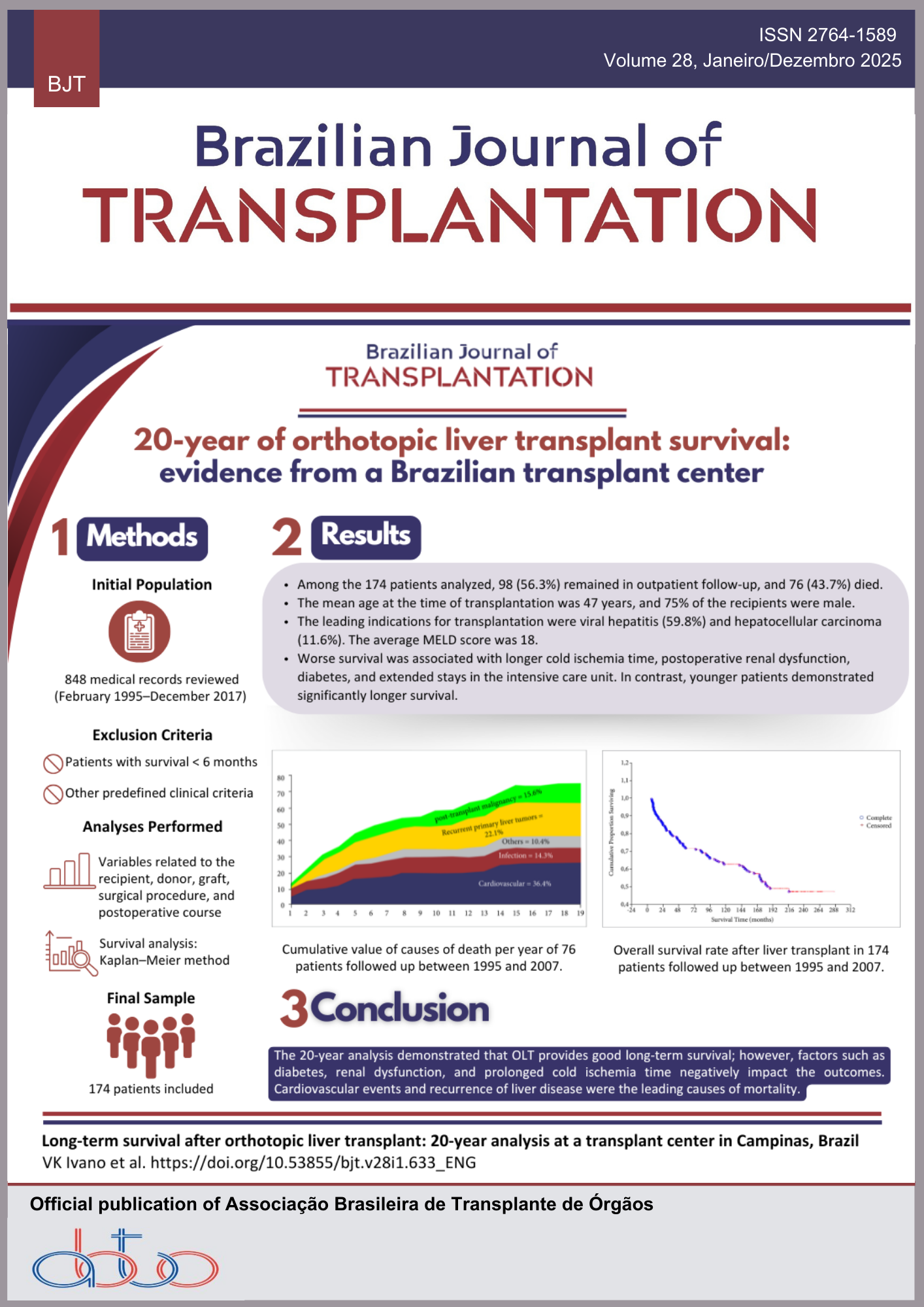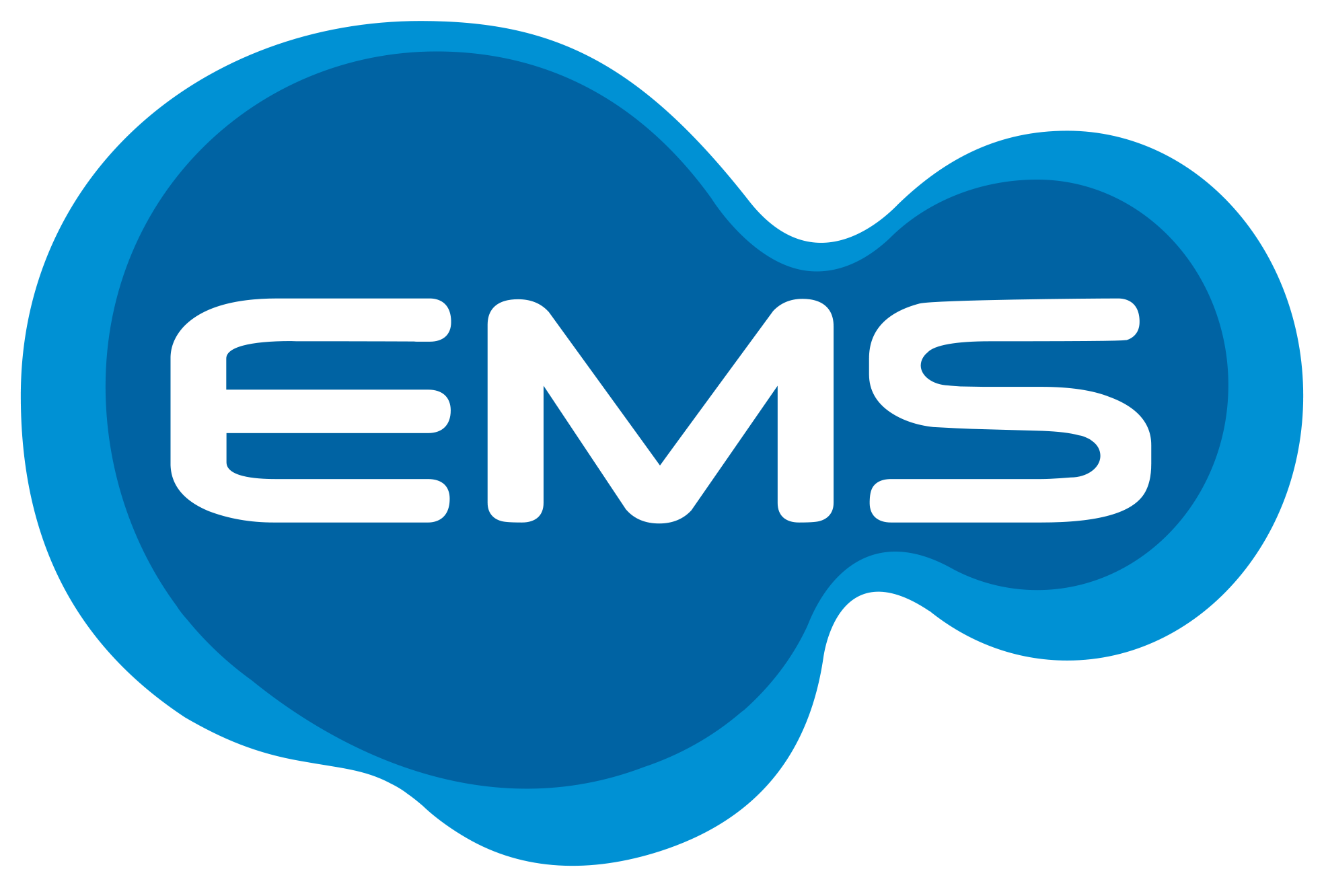The Role of Urine-1 and Urinalysis in the Diagnosis of Acute Kidney Injury in Liver Transplantation
Keywords:
Acute Kidney Injury, Biomarkers, Liver Transplant, Renal dialysisAbstract
Introduction: Acute kidney injury (AKI) is a common complication in the intensive care unit. Urine-1 (U-1) is a frequently overlooked tool for assessing AKI; moreover, there is no evidence-based consensus on its use. This study aimed to investigate the role of U-1 and urinary microscopy (UM) in diagnosing severe AKI and the need for renal replacement therapy (RRT) in patients undergoing liver transplantation (LT). Methods: Our hypothesis was to determine whether the urinary parameters available in U-1 and UM are associated with the diagnosis of severe AKI and the need for RRT. We evaluated U-1 and UM 6 hours after LTx. The criterion for diagnosing AKI was based on Kidney Disease Improving Global Outcomes (KDIGO) guidelines, relying solely on serum creatinine levels within one week. Results: Eighty-seven patients developed AKI in the first week after LT. The diagnosis of severe AKI (KDIGO 2 and 3) was found in 59 patients. Six hours after LT, the variables in U-1 were predictors of severe AKI, with the area under the curve (AUC) of 0.65 for proteins, 0.68 for leukocytes, and 0.63 for erythrocytes. In determining RRT, these variables performed better with AUC: 0.72 for proteins, 0.69 for leukocytes, and 0.68 for erythrocytes. The non-AKI and AKI groups showed a similar distribution in UM. Conclusion: Simple and commonly used parameters in clinical practice, such as proteinuria, erythrocyturia, and leukocyturia, can be valuable tools for diagnosing severe AKI and the need for RRT.
Downloads
References
Hoste EA, Bagshaw SM, Bellomo R, Cely CM, Colman R, Cruz DN. Epidemiology of acute kidney injury in critically ill patients: the multinational AKI-EPI study. Intensive Care Med. 2015;41:1411-23. https://doi.org/10.1007/s00134-015-3934-7
Bellomo R, Kellum J, Ronco C. Acute renal failure: time for consensus. Intensive Care Med. 2001; 27: 1685-8. https://doi. org/10.1007/s00134-001-1120-6
Clermont G, Acker CG, Angus DC, Sirio CA, Pinsky MR, Johnson JP. Renal failure in ICU: comparison of the impact of acute renal failure and end-stage renal disease on ICU outcomes. Kidney Int. 2002; 62: 986-96. https://doi.org/10.1046/ j.1523-1755.2002.00509.x
Xue JL, Daniels F, Star RA, Kimmel PL, Eggers PW, Molitoris BA, et al. Incidence and mortality of acute renal failure in Medicare beneficiaries, 1992 to 2001. J Am Soc Nephrol. 2006; 17: 1135-42. https://doi.org/10.1681/ASN.2005060668
Mehta RL, Pascual MT, Soroko S, Savage BR, Himmelfarb J, Ikizler TA, et al. Spectrum of acute renal failure in the intensive care unit: the PICARD experience. Kidney Int. 2004; 66: 1613-21. https://doi.org/10.1111/j.1523-1755.2004.00927.x
Kellum JA, Prowle JR. Paradigms of acute kidney injury in the intensive care setting. Nat Rev Nephrol. 2018; 14(4): 217-30. https://doi.org/10.1038/nrneph.2017.184
Barri YM, Sanchez EQ, Jennings LW, Melton LB, Hays S, Levy MF, et al. Acute kidney injury following liver transplantation: definition and outcome. Liver Transpl. 2009; 15(5): 475-83. https://doi.org/10.1002/lt.21682
Kidney Disease: Improving Global Outcomes (KDIGO), Acute Kidney Injury Work Group. KDIGO clinical practice guideline for acute kidney injury. Kidney Int. 2012; Suppl. 2: 1-138.
Echeverry G, Hortin GL, Rai AJ. Introduction to urinalysis: historical perspectives and clinical application. Methods Mol Biol. 2010; 641: 1-12. https://doi.org/10.1007/978-1-60761-711-2_1
Wang L, Li X, Chen H, Yan S, Li D, Li Y, Gong Z. Coronavirus disease 19 infection does not result in acute kidney injury: an analysis of 116 hospitalized patients from Wuhan, China. Am J Nephrol. 2020; 51(5): 343-8. https://doi.org/10.1159/000507471
Cheng Y, Luo R, Wang K, Zhang M, Wang Z, Dong L. Kidney disease is associated with in-hospital death of patients with COVID-19. Kidney Int. 2020; 97(5) 829-38. https://doi.org/10.1016/j.kint.2020.03.005
Li Z, Wu M, Yao J, Guo J, Liao X, Song S. Caution on kidney dysfunctions of 2019-nCoV patients. medRxiv. 2020. https:// doi.org/10.1101/2020.02.08.20021212
Cao M, Zhang D, Wang Y. Clinical features of patients infected with the 2019 novel coronavirus (COVID-19) in Shanghai, China. medRxiv. 2020. https://doi.org/10.1101/2020.03.04.20030395
Brasil. Ministério da Saúde. Portaria no 2.600, de 21 de outubro de 2009. Brasília (DF): Ministério da Saúde; 2009. [acesso em 10 ago 2024] Disponível em: https://bvsms.saude.gov.br/bvs/saudelegis/gm/2009/prt2600_21_10_2009.html
Perazella MA, Coca SG, Kanbay M, Brewster UC, Parikh CR. Diagnostic value of urine microscopy for differential diagnosis of acute kidney injury in hospitalized patients. Clin J Am Soc Nephrol. 2008; 3(6): 1615-9. https://doi.org/10.2215/ CJN.02860608
Linde JM, Nijman RJM, Trzpis M, Broens PMA. Prevalence of urinary incontinence and other lower urinary tract symptoms in children in the Netherlands. J Pediatr Urol. 2019;15(2): 164. e1-7. https://doi.org/10.1016/j.jpurol.2018.10.027
Kissling S, Rotman S, Gerber C, Halfon M, Lamoth F, Comte D. Collapsing glomerulopathy in a COVID-19 patient. Kidney Int. 2020; 98(1): 228-31. https://doi.org/10.1016/j.kint.2020.04.006
Larsen CP, Bourne TD, Wilson JD. Collapsing glomerulopathy in a patient with COVID-19. Kidney Int Rep. 2020; 5(6): 935- 9. https://doi.org/10.1016/j.ekir.2020.04.002
Nasr SH, Kopp JB. COVID-19-associated collapsing glomerulopathy: an emerging entity. Kidney Int Rep. 2020; 5(6): 759-61. https://doi.org/10.1016/j.ekir.2020.04.030
Martínez-Rojas MA, Vega-Vega O, Bobadilla NA. Is the kidney a target of SARS-CoV-2? Am J Physiol Renal Physiol. 2020; 318(6). https://doi.org/10.1152/ajprenal.00160.2020
Moreno JA, Martín-Cleary C, Gutiérrez E, Toldos O, Blanco-Colio LM, Praga M, et al. AKI associated with macroscopic glomerular hematuria: clinical and pathophysiologic consequences. Clin J Am Soc Nephrol. 2012; 7(1): 175-84. https://doi. org/10.2215/CJN.01970211
Moreno JA, Sevillano Á, Gutiérrez E, Guerrero-Hue M, Vázquez-Carballo C, Yuste C, et al. Glomerular hematuria: cause or consequence of renal inflammation? Int J Mol Sci. 2019; 20(9): 2205. https://doi.org/10.3390/ijms20092205
Gala-Błądzińska A, Żyłka A, Dumnicka P, Kuśnierz-Cabala B, Kaziuk MB, Kuźniewski M. Sterile leukocyturia affects urine neutrophil gelatinase-associated lipocalin concentration in type 2 diabetic patients. Arch Med Sci. 2017; 13(2): 321-7. https:// doi.org/10.5114/aoms.2016.64043
Karras A. Acute interstitial nephritis. Rev Prat. 2018; 68(2): 170-4.
D’Amico G, Bazzi C. Urinary protein and enzyme excretion as markers of tubular damage. Curr Opin Nephrol Hypertens. 2003 ;12: 639-43.
Pavenstädt H, Kriz W, Kretzler M. Cell biology of the glomerular podocyte. Physiol Rev. 2003; 83: 253-307. https://doi. org/10.1152/physrev.00020.2002
Klahr S, Miller SB. Acute oliguria. N Engl J Med. 1998; 338(10): 671-5. https://doi.org/10.1056/NEJM199803053381007
Esson ML, Schrier RW. Diagnosis and treatment of acute tubular necrosis. Ann Intern Med. 2002; 137(9):744-52. https://doi.org/10.7326/0003-4819-137-9-200211050-00010
Singri N, Ahya SN, Levin ML. Acute renal failure. JAMA. 2003; 289(6): 747-51. https://doi.org/10.1001/jama.289.6.747
Needham E. Management of acute renal failure. Am Fam Physician. 2005; 72(9): 1739-46.
Lameire N, Vanbiesen W, Vanholder R. Acute renal failure. The Lancet. 2005; 365(9457): 417-30. https://doi.org/10.1016/ S0140-6736(05)70238-5
Bagshaw SM, Haase M, Haase-Fielitz A, Bennett M, Devarajan P, Bellomo R. A prospective evaluation of urine microscopy in septic and non-septic acute kidney injury. Nephrol Dial Transplant. 2012; 27(2): 582-8. https://doi.org/10.1093/ndt/gfr331.
Barreto AG, Daher EF, Silva Junior GB, Garcia JH, Magalhães CB, Lima JM. Risk factors for acute kidney injury and 30-day mortality after liver transplantation. Ann Hepatol. 2015; 14: 688-94.
Baron-Stefaniak J, Schiefer J, Miller EJ, Berlakovich GA, BaronDM, Faybik P. Comparison of macrophage migration inhibitory factor and neutrophil gelatinaseassociated lipocalin-2 to predict acute kidney injury after liver transplantation: an observational pilot study. PLoS One. 2017; 12(8): 1-14. https://doi.org/10.1371/journal.pone.0183162
Downloads
Published
How to Cite
Issue
Section
License
Copyright (c) 2025 Camila Lima, Maria de Fatima Correa , Etienne Macedo

This work is licensed under a Creative Commons Attribution 4.0 International License.









